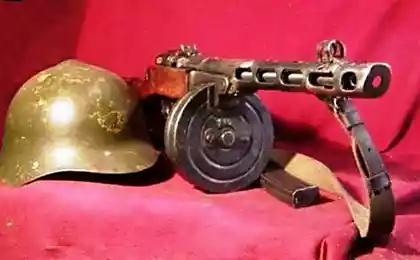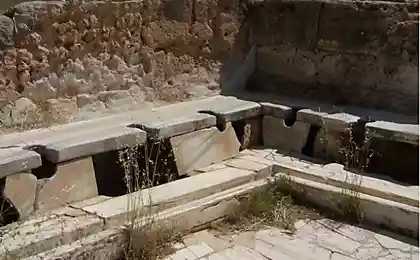910
10 facts about the terrible ancient weapons, which runs through the frost on the skin
Each weapon is made with a purpose: there are defensive, offensive there. And there is, which is manufactured specifically to deliver as much as possible the suffering of the enemy. The site publishes a collection of such species is so nervous to read no further! 1. KHOPESH h2> KHOPESH - kind of cold weapons of ancient Egypt to the crescent-shaped blade. The form and functionality is something between a sword and an ax. KHOPESH quite successfully combines features of both these tools weapons - weapons that can be cut down, cut, chop.
2. Kakute h2> Battle ring or kakute - non-lethal form of Japanese weapon that consists of a small hoop covering finger and naklёpannyh / tipped spikes (usually one to three).
3. Hook sword h2> hook sword - a sword with the tip of a hook, with a finial in the form of a sharp dagger and Garden sickle. As a result, a warrior, armed with such a strange weapon was able to fight at different distances as a close and at a distance from the enemy at a distance of the tip of the sword.
4. Chuang h2> Another Chinese weapons. Iron "hand" Chuang was our long stick, at the end of which was attached a copy of a human hand with huge claws, which are easily torn pieces of flesh from the body of the opponents. Himself weight Zhuang (about 9 kg) was enough to kill the enemy, but with claws it look even more eerie. If Chuang used the experienced warrior, he could pull off the soldiers with their horses. But the main purpose was to Zhuang pull shields out of the hands of opponents, leaving them vulnerable to deadly claws.
5. Skissor h2> In fact - metal sleeves, which ends with the edge of a semicircular shape. He served for defense, a successful block enemy attacks, as well as to apply their own beats. Wounds from skissora turned out not lethal, but very unpleasant, leading to profuse bleeding. Skissor was light, and had a length of 45 cm. The first application skissoru found Roman Gladiators, and if you look at the images of these fights, the majority of soldiers accurately distinguish skissor.
6. Serponosnye chariot h2> is an advanced war chariot with horizontal blade length of about one meter on each side of the wheel. Greek commander Xenophon, a member of the Battle of Cunaxa, telling them: "This was thin braids, extended at an angle from the axis, as well as under the seat of the driver, rotated to the ground».
7. Greek fire h2> The combustible mixture used for military purposes during the Middle Ages. For the first time it would be used for the Byzantines in sea battles. Installation of the Greek fire was a copper tube - siphon through which with a roar erupted liquid mixture. As buoyancy use compressed air, or like a blacksmith's bellows.
8. Morgenstern h2> Literally from German - "morning star". Cold Steel shock-crushing action in the form of a metal ball, fitted with spikes. Used as maces and flails tops. This greatly increases the weight of the pommel weapons - Morgenstern he weighed more than 1, 2 kg, which had a strong impact on the morale of the enemy, frightening him with his views.
9. Kusarigama h2> kusarigama consists of kama sickle, which is secured by a chain of shock load. Length folded sickle can reach 60 cm and a sickle blade length - up to 20 cm. Sickle blade perpendicular to the handle, it is sharpened on the inside, concave side and end tip. The chain is attached to the other end of the handle, or to the Obukhov sickle. Its length is about 2 to 5 m or less. Technique allow these weapons to inflict a blow using weights or confuse it with the chain, and then make an attack with a sickle. In addition, it was possible to throw at the enemy himself a sickle and then return it with a chain. Thus kusarigama used in the defense of fortresses.
10. Makuahutl h2> Aztec weapon resembling a sword. Its length usually reaches 90-120 cm. Along the wooden blades were attached pointy pieces of volcanic glass (obsidian). The wounds from the use of these weapons were obtained horrific due to a combination of sharp edge (enough to decapitate the enemy) and chipping that tore flesh. The last mention of makuahutle refers to 1884.
1. KHOPESH h2> KHOPESH - kind of cold weapons of ancient Egypt to the crescent-shaped blade. The form and functionality is something between a sword and an ax. KHOPESH quite successfully combines features of both these tools weapons - weapons that can be cut down, cut, chop.
The first mention of it appears in the New Kingdom, the latter - roughly around 1300 BC. e. Most often KHOPESH worked as an ax, in practice, to stop him hit only one blade is not possible - it breaks through.
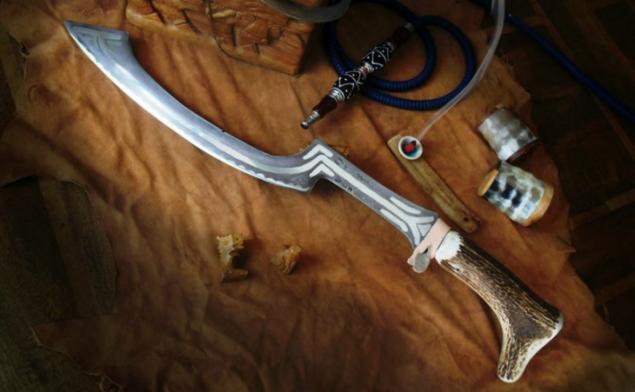
2. Kakute h2> Battle ring or kakute - non-lethal form of Japanese weapon that consists of a small hoop covering finger and naklёpannyh / tipped spikes (usually one to three).
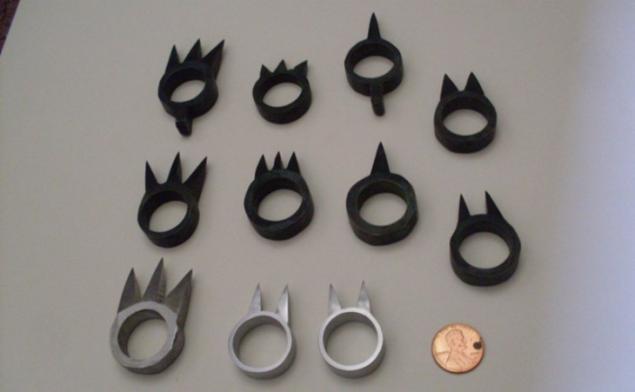
Warrior usually wore one or two rings - one at the middle or index finger, and the other at large. Most often rings were spiked into and used when needed to capture and retain the human, but not kill it and do not cause deep damage. However, if kakute spikes turned out, they were turned into jagged brass knuckles.
The purpose kakute was to subdue the enemy, not kill him. Particularly popular these fighting ring used at Kunoichi - Female Ninja. They used kakute covered with poison, for rapid, fatal attacks.
3. Hook sword h2> hook sword - a sword with the tip of a hook, with a finial in the form of a sharp dagger and Garden sickle. As a result, a warrior, armed with such a strange weapon was able to fight at different distances as a close and at a distance from the enemy at a distance of the tip of the sword.
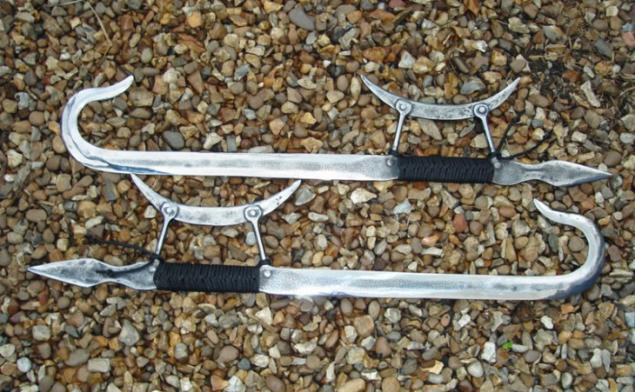
Sharpens the front of the blade, the concave part of the "guard", pommel handle and the outer side of the hook. Sometimes the inner side of the hook was not imprisoned, which allowed to carry out this part of the grip of the weapon and strikes like an ax, the same "mesyatsevidnoy hilt».
All this variety of blades allows you to combine tricks as at long range and close. Dagger handle can beat the reverse movement, sickle - garde not only cut the enemy, but beat on-Fisted.
Toe - hook sword allows not only hit the chopping or cutting motion, but also to hitch the enemy, grab a limb, hooking, pinching and lock arms, and then pull it. You could throw in hook sword hooks, and thus, increase the distance of a sudden attack.
4. Chuang h2> Another Chinese weapons. Iron "hand" Chuang was our long stick, at the end of which was attached a copy of a human hand with huge claws, which are easily torn pieces of flesh from the body of the opponents. Himself weight Zhuang (about 9 kg) was enough to kill the enemy, but with claws it look even more eerie. If Chuang used the experienced warrior, he could pull off the soldiers with their horses. But the main purpose was to Zhuang pull shields out of the hands of opponents, leaving them vulnerable to deadly claws.
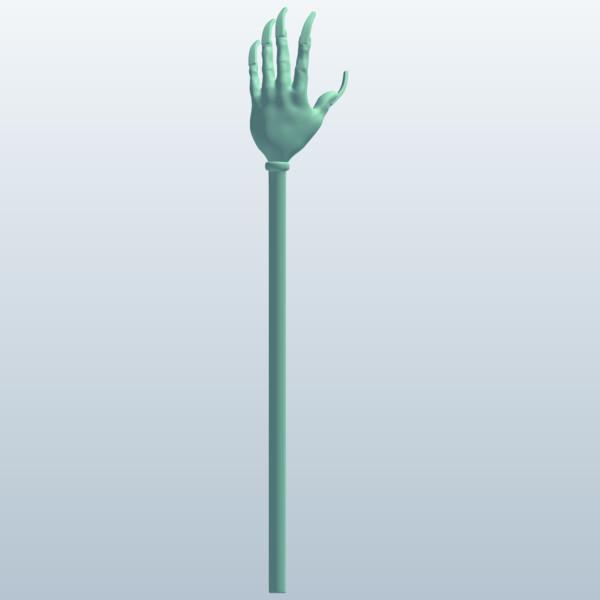
5. Skissor h2> In fact - metal sleeves, which ends with the edge of a semicircular shape. He served for defense, a successful block enemy attacks, as well as to apply their own beats. Wounds from skissora turned out not lethal, but very unpleasant, leading to profuse bleeding. Skissor was light, and had a length of 45 cm. The first application skissoru found Roman Gladiators, and if you look at the images of these fights, the majority of soldiers accurately distinguish skissor.
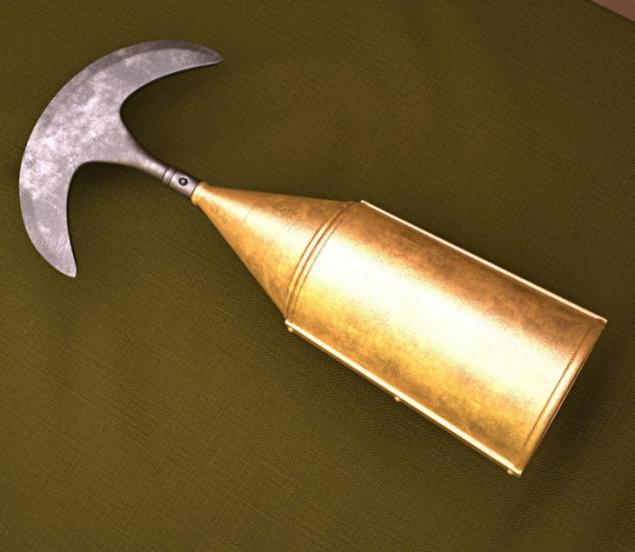
6. Serponosnye chariot h2> is an advanced war chariot with horizontal blade length of about one meter on each side of the wheel. Greek commander Xenophon, a member of the Battle of Cunaxa, telling them: "This was thin braids, extended at an angle from the axis, as well as under the seat of the driver, rotated to the ground».
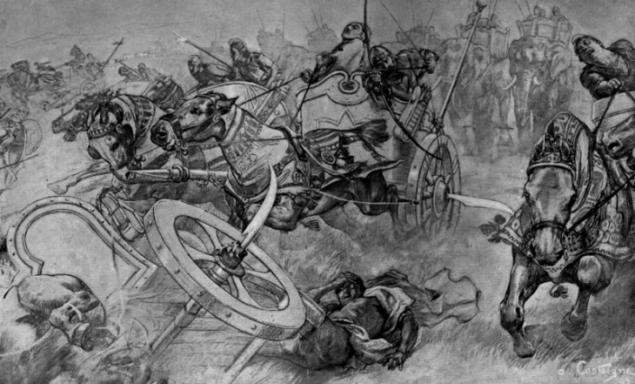
This weapon was used mainly for the frontal attack on the enemy system. The effect here was designed not only to the physical elimination of the enemy, but also at the psychological moment, which is demoralizing the enemy. The main objective was the destruction of serponosnye chariot combat formations of infantry.
7. Greek fire h2> The combustible mixture used for military purposes during the Middle Ages. For the first time it would be used for the Byzantines in sea battles. Installation of the Greek fire was a copper tube - siphon through which with a roar erupted liquid mixture. As buoyancy use compressed air, or like a blacksmith's bellows.
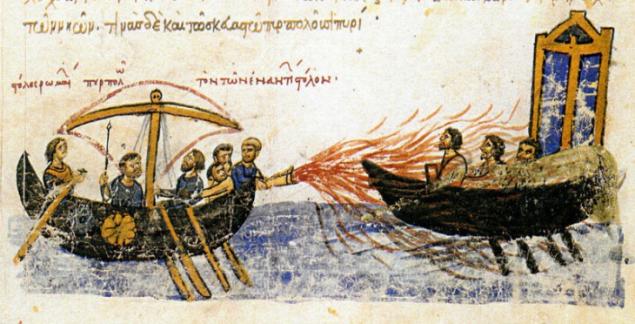
Presumably, the maximum long range siphons was 25-30 m, so initially the Greek fire was used only in the Navy, where he represented a dire threat to slow and clunky wooden ships of the time. In addition, according to contemporaries, the Greek fire could not be put out anything, because it continued to burn even on the surface of the water.
8. Morgenstern h2> Literally from German - "morning star". Cold Steel shock-crushing action in the form of a metal ball, fitted with spikes. Used as maces and flails tops. This greatly increases the weight of the pommel weapons - Morgenstern he weighed more than 1, 2 kg, which had a strong impact on the morale of the enemy, frightening him with his views.
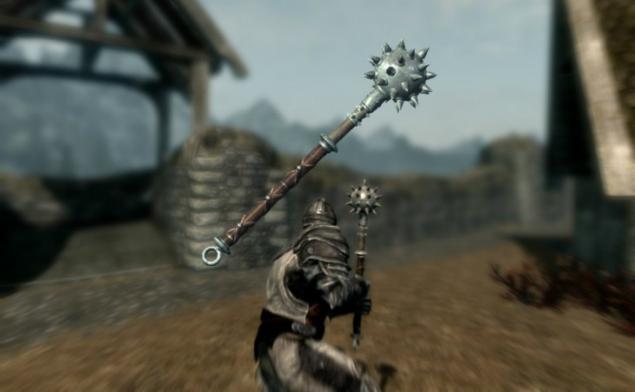
9. Kusarigama h2> kusarigama consists of kama sickle, which is secured by a chain of shock load. Length folded sickle can reach 60 cm and a sickle blade length - up to 20 cm. Sickle blade perpendicular to the handle, it is sharpened on the inside, concave side and end tip. The chain is attached to the other end of the handle, or to the Obukhov sickle. Its length is about 2 to 5 m or less. Technique allow these weapons to inflict a blow using weights or confuse it with the chain, and then make an attack with a sickle. In addition, it was possible to throw at the enemy himself a sickle and then return it with a chain. Thus kusarigama used in the defense of fortresses.
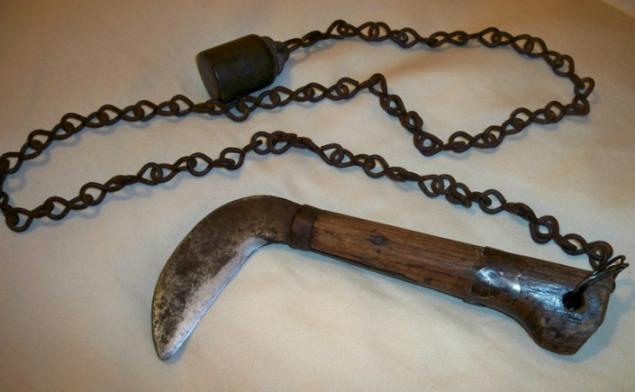
10. Makuahutl h2> Aztec weapon resembling a sword. Its length usually reaches 90-120 cm. Along the wooden blades were attached pointy pieces of volcanic glass (obsidian). The wounds from the use of these weapons were obtained horrific due to a combination of sharp edge (enough to decapitate the enemy) and chipping that tore flesh. The last mention of makuahutle refers to 1884.
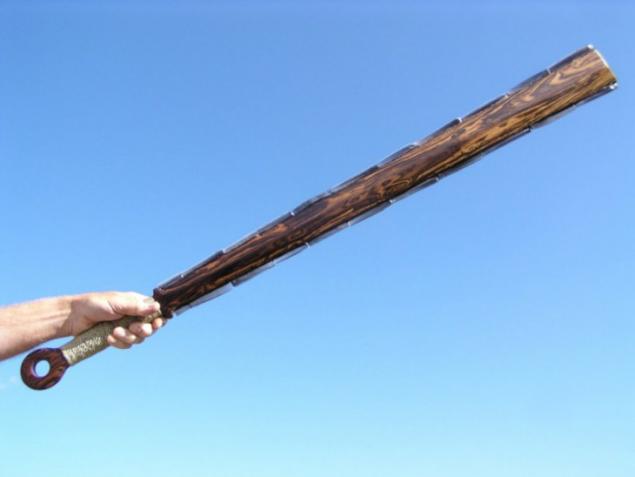
via fishki.net/1640808-10-samyh-zhutkih-vidov-drevnego-oruzhija.html
10 facts about oatmeal, breakfast convinced us it as often as possible
7 tricks to help you look great in photos
















